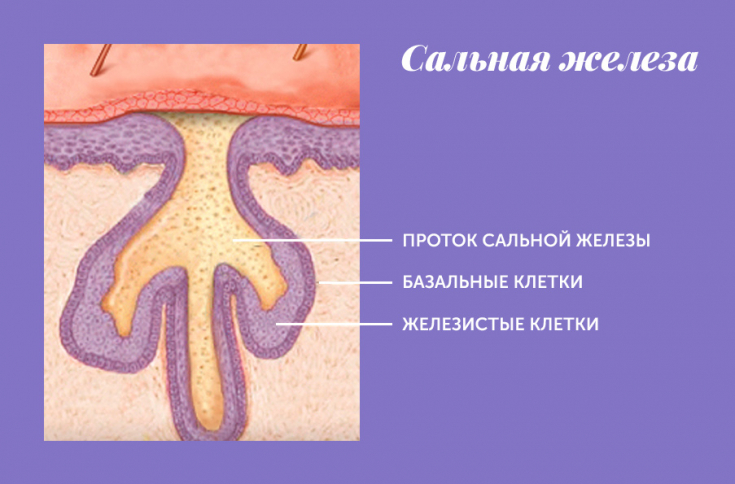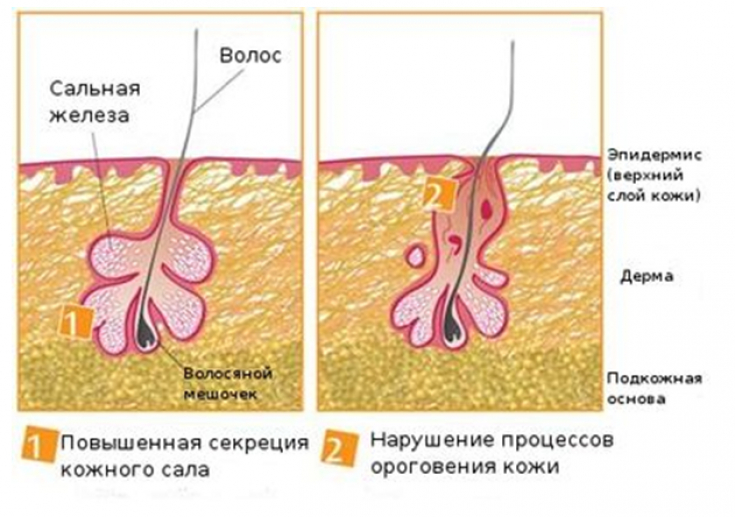In women with diseases of the sebaceous glands during menopause, structural and functional disorders occur in the skin, which clinically occur in the form of seborrhea, late acne and excessive dryness of the skin, and are the result of an established deficiency of sex steroid hormones, especially estradiol.
In addition to differences in the clinical picture, the course of diseases of the sebaceous glands during menopause, there are changes in skin morphology.
Only our article on estet-portal.com contains the most up-to-date data from research of women with sebaceous gland diseases during menopause and effective approaches to the treatment of this pathology.
Morphological changes in the sebaceous glands during menopause
During a morphological study of the skin of a group of patients, it was revealed that with slight fluctuations in the levels of sex hormones within the age norm, involutive hypotrophy of the skin appendages, thickening and tortuous nature of the fibrous structures of the dermis were observed, fibroblasts and macrophages predominated among the cells.
Follow us on Instagram!
For oily seborrhea − proliferative changes in the sebaceous glands of the skin in the form of an increase in their number compared to the age norm, structural polymorphism and hyperplasia, thickening of collagen, fragmentation and lysis of the reticular and elastic fibers of the sebaceous glands.

In patients with late acne, a picture of panniculitis was established, which in most cases was observed in patients with low levels of estradiol in the blood serum (within 0.17 ± 0.02 nmol / l), and morphologically looked like focal necrosis of adipose tissue of the skin with moderate regional inflammatory response. With excessive dryness of the skin, atrophy of the sebaceous glands, destruction of the fibrous structures of the dermis took place, the latter was more pronounced in patients where the level of estradiol averaged 0.27 ± 0.27 0.01nmol / l in most patients of this group, a picture of microvasculitis was found.
Five skin manifestations that can save lives if diagnosed
So, in the dermis, against the background of age-related changes, the established structural and functional disorders clinically proceeded in the form of seborrhea, late acne and excessive dryness of the skin. The described changes relate to all structural elements of the skin, including the sebaceous glands, especially age-related and pathological.
Thus, it can be assumed that these changes in the skin and sebaceous glands are associated with a deficiency of sex steroid hormones, primarily estradiol during menopause.
Functional skin tests
During the measurement of some functional parameters of the skin (acidity and fat content), an increase in the oil content of the facial skin in patients with seborrhea and late acne was revealed; in patients with late acne, this indicator was significantly higher in relation to the group of patients with uncomplicated seborrhea. With excessive dryness of the skin, on the contrary, there was a significant decrease in the fat content of the facial skin.
In the group of women with excessive dryness of the skin, there was a significant decrease in acidity in relation to this indicator in the group of patients with late acne. The lowest value of acidity was in the group of patients with acne tarda − this indicator had a possible difference relative to the group of women with excessive dry skin.
That is, the pH of the skin of the face in women with excessive dry skin and in patients with seborrhea had a slightly alkaline reaction, and in the group of patients with late acne - alkaline.
Localized linear scleroderma: types, treatments
Thus, the above hormonal status disorders, and, as a result, the established changes in the structural and functional state of the skin and morphological and functional changes in the dermis in women with sebaceous gland diseases during menopause served as the basis for the development of a comprehensive pathogenetic rationale for treatment using substitution therapy to correct endocrine imbalance.
Hormone replacement therapy during menopause
As a result of complex treatment with the use of hormone replacement therapy, a positive trend in hormonal changes was observed.
As a result, the morphological picture of the skin after treatment of the oily form of seborrhea looked like a decrease in proliferative changes in the sebaceous glands; after treatment of late acne − as coarse fibrous macrofocal sclerosis against the background of the absence of inflammatory changes (sanation of panniculitis), after the elimination of excessive dryness of the skin − single reduced sebaceous glands, structurally close to the physiological and functional age norm, stabilization of the process and formation of fibrous structures of the dermis.
Systemic antibiotic therapy in the treatment of acne
Thus, the positive dynamics of the processes was realized due to the formation of fibrous structures against the background of a decrease in the level of inflammatory changes and stabilization of the trophism of all structural components of the dermis, skin and sebaceous glands. These dynamics of clinical improvement in patients were noted from a slight improvement in the condition of the skin to complete clinical recovery. So, when prescribing hormone replacement therapy during menopause, improvement and complete clinical recovery in patients with seborrhea was observed approximately at the 8th week of treatment, in patients with late acne - at the 12th, and at the 10th week - in women with excessive dry skin during menopause.
At the same time, in the group with the generally accepted complex of therapy, the treatment process was very slow and had a protracted character with relapses.
Hormonal changes in diseases of the sebaceous glands
A new solution to the scientific problem is to increase the effectiveness of therapy for women with diseases of the sebaceous glands during menopause by using hormone replacement therapy in the complex treatment based on the establishment of the pathogenetic role of hormonal homeostasis disorders.

In women with diseases of the sebaceous glands during menopause, an imbalance in the level of sex steroid hormones in the blood serum was found in the form of relative hyperandrogenemia and relative hyperprogesteronemia against the background of absolute hypoestrogenism in patients with uncomplicated seborrhea and late acne. In women with excessive dryness of the skin, an increase in the levels of gonadotropic hormones (FSH, LH) was revealed, and in women with diseases of the sebaceous glands during menopause − high LH level in the group of patients with late acne.
The meaning of the derived elements of the skin: sebaceous and sweat glands
In cases of sebaceous gland diseases in menopausal women with signs of climacteric syndrome (according to the analysis of clinical and laboratory, instrumental, enzyme immunoassay, radioimmune research methods, taking into account the established changes in the endocrine system, disorders in the structural and functional state of the bone tissue) hormone replacement therapy is recommended as part of a complex method of treatment along with conventional therapy for skin diseases in order to increase the effectiveness and positive dynamics of the prescribed treatment regimen.
Modern aspects of diagnosis and treatment of rosacea







Add a comment